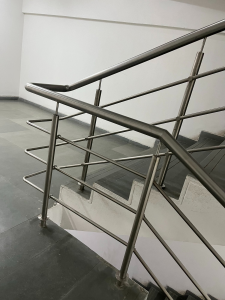Cost Considerations for Stainless Steel Railings
When selecting and installing stainless steel railings, it’s essential to consider the costs involved. Stainless steel railings are a popular choice for residential and commercial properties due to their durability, aesthetics, and low maintenance requirements.
Material Costs
- Type of Stainless Steel: Stainless steel comes in various grades, with 304 and 316 being the most common for railings. The grade you choose can significantly impact material costs. While 304 stainless steel is less expensive, 316 stainless steel offers better corrosion resistance and is often preferred for outdoor applications.
- Railing Design: The complexity of your railing design plays a crucial role in material costs. Elaborate or custom designs with intricate details and curves will require more material, increasing costs.
- Finish and Coating: The finish and coating of the stainless steel can also affect costs. Polished or brushed finishes are popular but can be more expensive than a simple satin finish. Adding protective coatings, such as a clear powder coat, can increase costs but may extend the railing’s lifespan.
- Accessories: Accessories like balusters, brackets, and handrails are necessary components of a railing system. The choice of these accessories, as well as their design and quality, will impact material costs.

Labor Costs
- Installation Complexity: The complexity of the installation process will affect labor costs. For example, if your railing system needs to be customized to fit a curved staircase or unique architectural features, it will require more time and expertise, increasing labor costs.
- Location: Labor costs can vary based on your location and the availability of skilled installers. In areas with a high cost of living, labor costs tend to be higher. Additionally, some locations may have specific building codes and regulations that could affect installation complexity and cost.
- Project Size: Larger projects that require more linear feet of railing will naturally have higher costs. Conversely, smaller projects may be more cost-effective in terms of labor.
- Demolition and Removal: If your project involves removing existing railings, this will add to the labor costs. The complexity of the removal process can also influence the overall cost.
Maintenance Costs
One of the advantages of stainless steel railings is their low maintenance requirements. However, there are still some maintenance costs to consider:
- Cleaning and Maintenance Supplies: You’ll need to invest in cleaning supplies, such as stainless steel cleaners, to keep your railings looking their best. Regular cleaning is essential, especially in high-traffic areas.
- Inspection and Repairs: Periodic inspections to check for signs of corrosion or damage are advisable. While stainless steel is corrosion-resistant, it’s not completely immune. Any necessary repairs should be factored into your maintenance budget.
- Long-Term Replacement: Over an extended period, stainless steel railings may require replacement due to wear and tear. Understanding the expected lifespan of your railing system and budgeting for eventual replacement is essential.
Stainless steel railings offer numerous advantages, but their cost considerations are crucial for budgeting and decision-making. To assess your unique requirements and provide a detailed cost breakdown, including material, labor, and maintenance costs. Considering these factors, you can make an informed decision that aligns with your budget and design preferences while ensuring a long-lasting and aesthetically pleasing stainless steel railing system.

 +86 159 6420 9667
+86 159 6420 9667  sales@haxrailing.com
sales@haxrailing.com 



